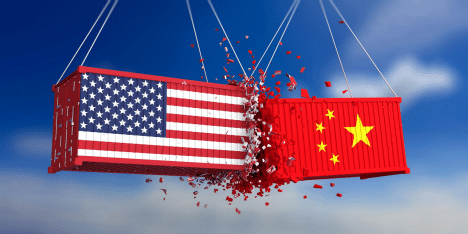
Geopolitical conflicts, whether overt military engagements or protracted periods of elevated tension, cast long and complex shadows across the global economic landscape, and the United States business sector is no exception. While some industries may experience ephemeral booms, the pervasive repercussions often include supply chain fragility, inflationary pressures, shifts in consumer behavior, and reconfigurations of investment patterns. Understanding these intricate dynamics is crucial for U.S. businesses striving to maintain equilibrium and foster resilience in an increasingly volatile world.
The Economic Repercussions: A Double-Edged Sword
The immediate aftermath of a significant geopolitical conflict often presents a bifurcated economic reality for U.S. businesses. Certain sectors may experience a sudden surge in demand, while others grapple with unprecedented disruption.
Defense Sector Ascendancy: The Apex of Armament
Unsurprisingly, industries directly involved in national defense and security typically witness a substantial upsurge in activity during periods of conflict. Manufacturers of aerospace systems, armaments, cybersecurity solutions, and surveillance technologies often receive substantial government contracts. This can lead to increased production, job creation within these specialized fields, and significant revenue growth for companies like Lockheed Martin, Boeing, and Raytheon. This phenomenon has historically given rise to what President Eisenhower famously termed the “military-industrial complex,” a symbiotic relationship between government and defense contractors.
Supply Chain Precarity: The Achilles’ Heel of Modern Commerce
Conversely, the pervasive interconnectedness of modern global supply chains renders them profoundly vulnerable to geopolitical instability. Wars can disrupt established trade routes, leading to delays, increased transportation costs, and shortages of critical raw materials and components. For instance, conflicts in regions vital for energy production can cause oil and gas prices to skyrocket, impacting virtually every industry from manufacturing to transportation. The semiconductor industry, heavily reliant on a concentrated global supply, faces existential threats from regional conflicts that could disrupt chip fabrication, with cascading effects on electronics, automotive, and technology sectors across the U.S. Businesses are compelled to re-evaluate their sourcing strategies, often pursuing diversification, nearshoring, or even reshoring initiatives to fortify their logistical fortitude against such exogenous shocks.
Macroeconomic Tremors: Inflation, Investment, and Labor Market Shifts
Beyond immediate sectoral impacts, protracted conflicts instigate broader macroeconomic shifts that permeate the entire U.S. business ecosystem.
The Inflationary Impetus: Price Escalation as a Consequence
Wars are inherently inflationary. Increased government spending on defense, coupled with supply-side constraints, can lead to a surfeit of money chasing a scarcity of goods and services. This disequilibrium manifests as rising prices for commodities, manufacturing inputs, and consumer goods. For U.S. businesses, this translates into higher operational costs, squeezing profit margins unless these increases can be effectively passed on to consumers. The erosion of purchasing power can also dampen consumer demand, creating a challenging environment for non-essential goods and services.
Investment Axioms Recalibrated: Aversion to Volatility
Geopolitical instability engenders an inherent aversion to risk among investors. Foreign direct investment (FDI) into regions perceived as volatile may diminish, potentially diverting capital flows to more stable economies, including, at times, the U.S. domestic market. However, even within the U.S., prolonged conflict can create uncertainty, leading businesses to defer capital expenditures, delay expansion plans, and adopt a more conservative fiscal posture. This can stifle innovation and long-term economic growth. Companies with significant international operations may also reassess their global footprint, potentially divesting from or scaling back operations in conflict-affected zones.
The Evolving Labor Tapestry: Recruitment and Retention in Flux
While defense industries may experience a surge in demand for labor, other sectors might face unique challenges. Military mobilizations can draw individuals from the civilian workforce, creating localized labor shortages. Moreover, the psychological toll of conflict can influence consumer confidence and overall economic sentiment, potentially impacting hiring decisions. Businesses may also need to adapt to a workforce that is more keenly aware of global events, with a greater emphasis on corporate social responsibility and ethical sourcing. The demand for specific skills, particularly in logistics, cybersecurity, and advanced manufacturing, often intensifies during periods of geopolitical tension.
Enduring Transformations: Innovation and Regulatory Evolution
Despite the myriad challenges, conflict can also act as a crucible for innovation and prompt significant shifts in regulatory frameworks, with enduring implications for U.S. businesses.
The Crucible of Innovation: Technological Accelerants
Historically, periods of conflict have spurred unprecedented technological advancements. Wartime exigencies often accelerate research and development in areas such as aerospace, computing, materials science, and medical technologies. Innovations developed for military applications frequently find subsequent civilian uses, fostering entirely new industries and improving existing ones. For U.S. businesses, this means a potential surge in opportunities for companies at the vanguard of dual-use technologies, from advanced robotics to artificial intelligence and biotechnology. The competitive landscape itself can be reshaped by these rapid technological leaps.
Regulatory Realignment: Government Intervention and Oversight
Periods of conflict often necessitate increased government intervention in the economy to mobilize resources, manage supply chains, and regulate prices. This can lead to new regulatory frameworks, stricter compliance requirements, and heightened oversight of various industries. While some businesses may chafe under these constraints, others learn to adeptly navigate the new bureaucratic topography, often finding opportunities in strategic partnerships with government agencies. The focus on national security can also lead to protectionist trade policies and increased scrutiny of foreign investments in critical sectors.
In conclusion, the impact of war on U.S. businesses is a complex and often contradictory phenomenon. While certain segments may benefit from heightened defense spending, the broader economic ramifications — including supply chain vulnerabilities, inflationary pressures, dampened consumer sentiment, and shifts in investment — demand strategic foresight and agile adaptation. The prudent U.S. business enterprise in an era of geopolitical volatility must cultivate resilience, embrace technological evolution, and possess an acute awareness of the cascading effects of global conflict to navigate the treacherous currents and emerge with enduring vitality.